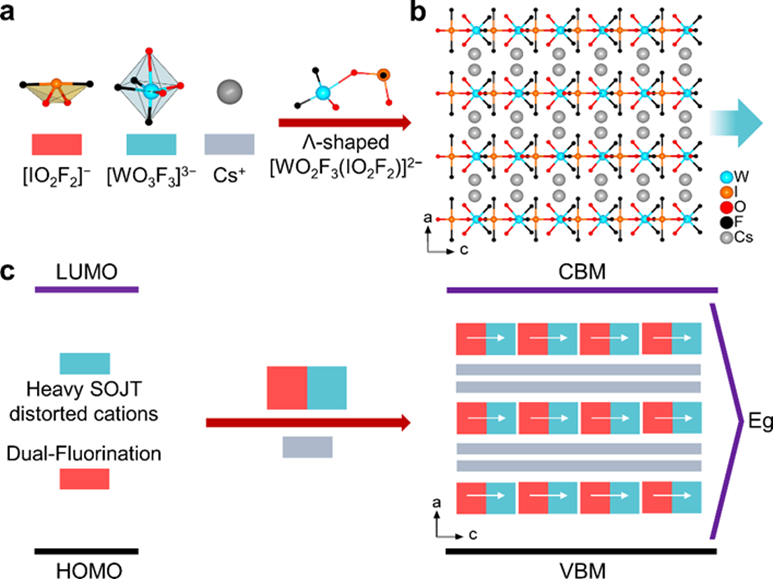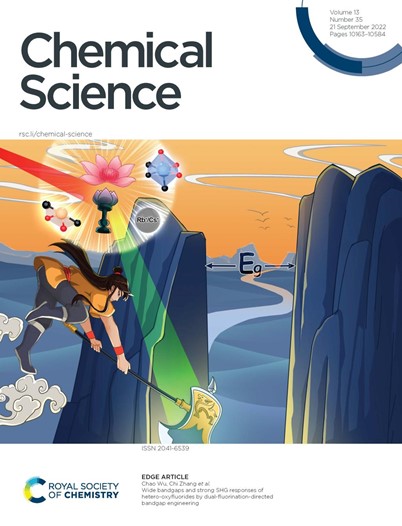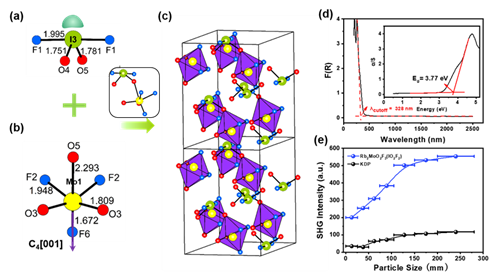Nonlinear optical crystals are important optoelectronic crystals that can realize nonlinear processes such as frequency doubling, sum frequency, difference frequency, optical difference amplification, and multiphoton absorption. They have important applications in laser frequency conversion, optical communication, deep space exploration, and military technology. High-performance second-order nonlinear optical materials that have strong nonlinear optical properties are expected to meet the requirements of wide light transmission range, large bandgaps, and high laser damage threshold. At present, the combination of two or more cations with second-order Jiang-Taylor distortion (such as d0 transition metal cations and stereochemically active lone pairs of cations) can enable crystalline materials to obtain strong frequency doubling responses. However, due to the existence of d0 transition metals, such materials often exhibit relatively narrow optical band gaps, which limits the optical transmission range of materials and renders it difficult to meet the practical application requirements of second-order nonlinear optical crystals.

The combination of two or more cations with second-order Jiang-Taylor distortion (such as d0 transition metal cations and stereochemically active lone pairs of cations) can enable crystalline materials to obtain strong second-harmonic responses
The research team of Professor ZHANG Chi from the School of Chemical Science and Engineering of our university, a member of the European Academy of Sciences, did research on iodate and proposed a molecular design strategy of difluorination to regulate the energy band structure, and created the first crystal material of 5d0 transition metal fluoridated A2WO2F3 (IO2F2) (A=Rb (RWOFI), Cs (CWOFI)). RWOFI and CWOFI have shown the broadest gap in the d0 transition metal iodate system so far, and also have strong frequency doubling response and wide optical transparent window. Their research results on "Wide bandgaps and strong SHG responses of hetero-oxyfluoride by dual fluoride- directed bandgap engineering" have been published as an Edge Article in Chemical Science (2022, 13, 10260-10266) recently. The article was selected as the cover article of the journal. The cover is set against the Chinese legend "CHEN Xiang splits the mountain to save his mother" with the Baolian Lantern symbolizing the crystal material created. Under the influence of two oxyfluoride anions with second-order Jiang-Taylor distortion, the Lantern empowers CHEN Xiang with huge energy and helps him split a wide crack on Huashan Mountain. The crack represents a wide optical bandgap of the crystal. The cover illustrates vividly that the application of difluorination-guided bandgap engineering strategy enables the synthesis of heterooxyfluoride to achieve synchronous gain of wide bandgap and strong frequency doubling effect.

Research results on wide bandgaps and strong frequency doubling responses in the fluoride iodate crystal by ZHANG Chi's team published in Chemical Science
In this study, the research team difluorinated two kinds of second-order Jiang-Taylor distorted heavy ions, I5+ with lone pair electrons and W6+ with low effective electronegativity, which brought about significant differences in the energy band structure, thus effectively enhancing the linear and second-order nonlinear optical properties of the material. At the same time, fluorine acts as a chemical "scissors" to induce two fluoro oxygen anion units to share oxygen sites, forming a zero-dimensional structure of λ configuration [WO2F3 (IO2F2)] 2−. These structures are stacked along the c-axis, which is conducive to the superposition of the second-order micro polarizability of groups. The research team also used X-ray diffraction analysis of single crystal structure in combination with density functional theory to conduct simulation calculations, and found out that the gain of bandgaps and frequency doubling effect in RWOFI and CWOFI can be attributed to [WO3F3] 2 − and [IO2F2] − the effective arrangement of oxygen fluoride anions. The fluoride iodate showed a strong frequency doubling effect (3.8 × KDP (RWOFI) and 3.5 × KDP (CWOFI) at 1064 nm, which can realize phase matching. The fluorinated iodate also has a wide optical transmission window covering the ultraviolet to mid-infrared bands and a wide optical bandgap (4.42 eV (RWOFI) and 4.28 eV (CWOFI), which is the maximum in the d0 transition metal iodate system). The engineering strategy of difluorinated guided band proposed in this research provides a new approach to the development of high-performance second-order nonlinear optical materials.

The research team also used X-ray diffraction analysis of single crystal structure in combination with density functional theory to conduct simulation calculations, and found out that the gain of bandgaps and frequency doubling effect in RWOFI and CWOFI can be attributed to [WO3F3] 2 − and [IO2F2] − the effective arrangement of oxygen fluoride anions.
The research was supported by the key projects of NSFC, MOE Innovation Team Scheme, the Innovation Team In Key Fields Scheme of the Ministry of Science and Technology, the Talent Introduction Plan of the Ministry of Education State Administration of Foreign Experts Affairs, and the Science and Innovation Plan of Shanghai Municipal Education Commission. ZHANG Chi is the corresponding author of the paper, and HU Yilei, a doctoral candidate of the School of Chemical Science and Engineering, Associate Professor WU Chao, and Dr. XUE Yanyan from the School of Physical Science and Engineering were the co-first authors of the paper. Professor HUANG Zhipeng from the School of Chemical Science and Engineering and Professor XU Jun from the School of Physical Science and Engineering participated in the relevant research work.
Article link: https://pubs.rsc.org/en/content/articlelanding/2022/sc/d2sc02137d